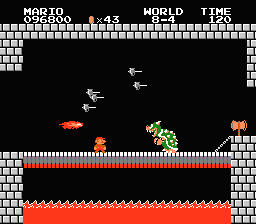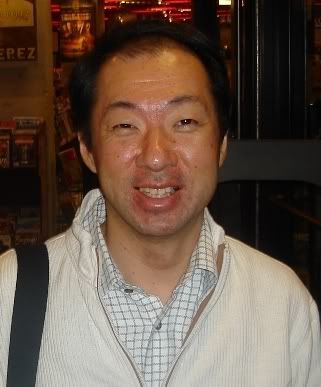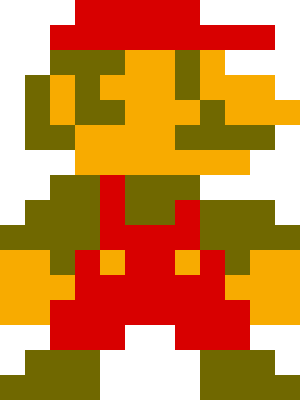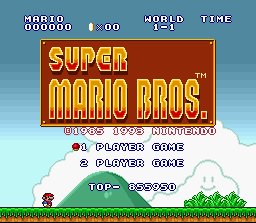AA2 Week 1 – Introduction to Game Audio
Super Mario Brothers (1985) Nintendo
[1]
Super Mario Brothers, in my opinion, is the most popular and influential video games of all time. This game has continually had new versions made for new platforms and also had older versions now available using emulators. E.g. the original Super Mario World (on SNES) is now available on the Gameboy Advanced and Nintendo DS.[1]
 [1]
[1]Nintendo first released Super Mario on the Nintendo Entertainment System (NES) in 1985. The NES had a total of five sounds channels. These included:
- 2 x pulse wave channels with a volume resolution of 16 (Supported frequencies between 54Hz & 28kHz).
- 1 x fixed volume triangle wave (supporting frequencies between 27Hz & 56kHz)
- 1 x white noise generator (16 pre-programmed frequencies) with a volume resolution of 16 (two modes by adjusting inputs on a linear feedback shift register)
- 1 x delta pulse-width modulation channel (6 bit range) with 16 pre-programmed sample rates between 4.2kHz & 33.5kHz. This channel was also capable of playing standard pulse-code modulation (PCM) by writing individual 7-bit values at timed intervals
CPU - 8-bit / 1.79MHz
Memory - 2kB onboard RAM
Game cartridges have their own RAM, which will increase the amount of memory. The NES supports a total of 48kB of RAM.[2]
[1]
 The final showdown. . .
The final showdown. . . So now that you have an idea of the specs of the old school Nintendo it is easier to understand the quality and possibility of the sound FX and music. The NES was an 8-bit video game console meaning that the sound quality was quite inferior to today’s’ standards. 8-bit sound FX are not such a problem as any kind of distortion could add to the sound. Sounds like Mario jumping, power up FX, dieing etc. do not need to be of high quality.
 [1]
[1]The music in Super Mario Brothers, written by Koji Kondo, is played in such a way that can be repeated and not drive the gamer insane. A lot of the music in other levels is a variant of the original theme. Kondo has received some criticism for this.[3]
[3] Koji has a lot to smile about. He is still producing video game music today. . .
Koji has a lot to smile about. He is still producing video game music today. . .
I think the music quality was good for that era. In 1985 digital audio in general was very new and the storage of digital sound and music was difficult. I think the music for Super Mario Brothers and the NES in general were revolutionary of that time.[4]
[5]
I thought I'd leave a movie of me playing the game. . .
[1] wikipedia. Super Mario Brothers, http://en.wikipedia.org/wiki/Super_Mario_Bros (Accessed 26/7/7)
[2] wikipedia. Nintendo Entertainment System, http://en.wikipedia.org/wiki/Nintendo_Entertainment_System (Accessed 26/7/7)
[3] wikipedia. Koji Kondo, http://en.wikipedia.org/wiki/Koji_Kondo (Accessed 26/7/7)
[4] Christian Haines "Audio Arts: Semester 2, Week 1: Introduction to Game Audio" Lecture presented at the Electronic Music Unit, University of Adelaide, 24th July 2007.
[5] youtube. Super Mario Brothers in 5 Minutes, http://www.youtube.com/watch?v=NPjsBsz4trk (Accessed 27/7/7)

[1]
 Koji has a lot to smile about. He is still producing video game music today. . .
Koji has a lot to smile about. He is still producing video game music today. . .I think the music quality was good for that era. In 1985 digital audio in general was very new and the storage of digital sound and music was difficult. I think the music for Super Mario Brothers and the NES in general were revolutionary of that time.[4]
[5]
I thought I'd leave a movie of me playing the game. . .
[1] wikipedia. Super Mario Brothers, http://en.wikipedia.org/wiki/Super_Mario_Bros (Accessed 26/7/7)
[2] wikipedia. Nintendo Entertainment System, http://en.wikipedia.org/wiki/Nintendo_Entertainment_System (Accessed 26/7/7)
[3] wikipedia. Koji Kondo, http://en.wikipedia.org/wiki/Koji_Kondo (Accessed 26/7/7)
[4] Christian Haines "Audio Arts: Semester 2, Week 1: Introduction to Game Audio" Lecture presented at the Electronic Music Unit, University of Adelaide, 24th July 2007.
[5] youtube. Super Mario Brothers in 5 Minutes, http://www.youtube.com/watch?v=NPjsBsz4trk (Accessed 27/7/7)



1 comment:
it's great to know the history behind the games i still love today :) It's hard to believe anything could run off of a combined 50kb of RAM lol! ... those were the days
Post a Comment